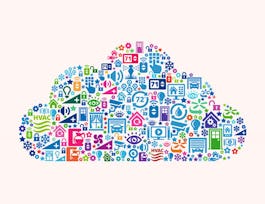The Raspberry Pi uses a variety of input/output devices based on protocols such as HDMI, USB, and Ethernet to communicate with the outside world. In this class you will learn how to use these protocols with other external devices (sensors, motors, GPS, orientation, LCD screens etc.) to get your IoT device to interact with the real world. Most physical devices use analog signals; however computer hardware is digital so in this class you will learn how these signals are converted back-and-forth and how this must be considered as you program your device. The basic design of a sensor-actuator system will also be covered. You will also learn how to build more sophisticated hardware systems using Raspberry Pi expansion boards to create fun and exciting IoT devices. Please note that this course does not include discussion forums.



Interfacing with the Raspberry Pi
This course is part of An Introduction to Programming the Internet of Things (IOT) Specialization

Instructor: Ian Harris
Sponsored by BrightStar Care
81,554 already enrolled
(1,596 reviews)
Skills you'll gain
Details to know

Add to your LinkedIn profile
4 assignments
See how employees at top companies are mastering in-demand skills

Build your subject-matter expertise
- Learn new concepts from industry experts
- Gain a foundational understanding of a subject or tool
- Develop job-relevant skills with hands-on projects
- Earn a shareable career certificate


Earn a career certificate
Add this credential to your LinkedIn profile, resume, or CV
Share it on social media and in your performance review

There are 4 modules in this course
This module presents the use of the Raspberry Pi to connect to the Internet, from a user perspective. The first way to use the Raspberry Pi as a networked device is to use it as a general-purpose computer rather than as a programmed IoT device. Using networking with a Raspberry Pi in this way is similar to using the network from any Linux machine, and we present its use in this module. We also present the standard Internet protocols that must be understood in order to develop network programs.
What's included
10 videos4 readings1 assignment1 peer review
This module introduces the networking socket interface that is used to transfer data across the network programmatically. An essential aspect of the Internet of Things is for your IoT device to send and receive data on the Internet, and the socket interface is key to enabling that. We describe how to use socket in Python to act as both a client and a server.
What's included
9 videos2 readings1 assignment1 peer review
This module focuses on how to have your Raspberry Pi interact with online services through the use of public APIs and SDKs. Many interesting and useful services are available in the cloud and this module describes how to write code that accesses those services. We define what an Application Programming Interface (API) is and what a Software Development Kit (SDK) is. We present some API examples and we show the use of the Twitter API in detail using the Twython package.
What's included
11 videos2 readings1 assignment1 peer review
In this module we show how to use the Raspberry Pi to interface with more complicated sensors and actuators. We explore the use of the Raspberry Pi camera module and the use of a servo. The Raspberry Pi camera module is used through the picamera library, which we describe. Servos are controlled by generating pulse width modulated signals and varying their pulse width using library functions.
What's included
9 videos3 readings1 assignment1 peer review
Instructor

Offered by
Why people choose Coursera for their career




Learner reviews
1,596 reviews
- 5 stars
75.56%
- 4 stars
19.48%
- 3 stars
2.88%
- 2 stars
1.12%
- 1 star
0.93%
Showing 3 of 1596
Reviewed on Nov 24, 2018
Course is great, but it takes forever to grade classmates. For example, by the end of the last week homework , I had to wait two weeks till someone was available to grade.
Reviewed on May 22, 2016
Good class. not much different than the Arduino one. Useful to learn and use SSH with linux if you do not have a monitor for your Raspberri Pi.
Reviewed on Jul 2, 2020
Nice way of teaching how to interact with raspberry pi .. A very good blend of theory + practical both revolving around the raspberry pi.
Recommended if you're interested in Physical Science and Engineering

L&T EduTech

University of California San Diego

University of California San Diego

University of California, Irvine

Open new doors with Coursera Plus
Unlimited access to 10,000+ world-class courses, hands-on projects, and job-ready certificate programs - all included in your subscription
Advance your career with an online degree
Earn a degree from world-class universities - 100% online
Join over 3,400 global companies that choose Coursera for Business
Upskill your employees to excel in the digital economy


